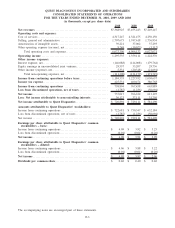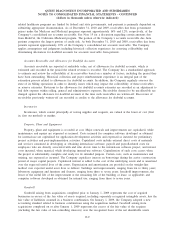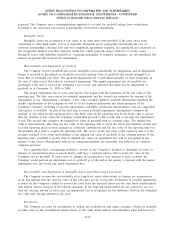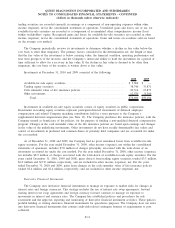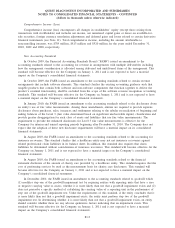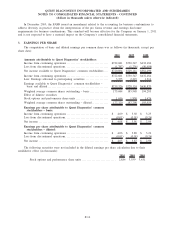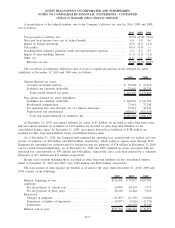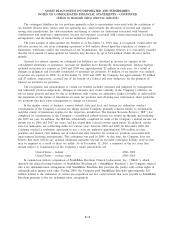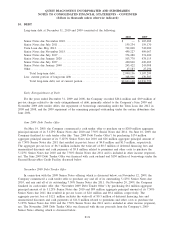Quest Diagnostics 2010 Annual Report Download - page 79
Download and view the complete annual report
Please find page 79 of the 2010 Quest Diagnostics annual report below. You can navigate through the pages in the report by either clicking on the pages listed below, or by using the keyword search tool below to find specific information within the annual report.Comprehensive Income (Loss)
Comprehensive income (loss) encompasses all changes in stockholders’ equity (except those arising from
transactions with stockholders) and includes net income, net unrealized capital gains or losses on available-for-
sale securities, foreign currency translation adjustments and deferred gains and losses related to certain derivative
financial instruments (see Note 11). Total comprehensive income, including the amount attributable to
noncontrolling interests, was $789 million, $813 million and $520 million for the years ended December 31,
2010, 2009 and 2008, respectively.
New Accounting Standards
In October 2009, the Financial Accounting Standards Board (“FASB”) issued an amendment to the
accounting standards related to the accounting for revenue in arrangements with multiple deliverables including
how the arrangement consideration is allocated among delivered and undelivered items of the arrangement. This
standard will become effective for the Company on January 1, 2011 and is not expected to have a material
impact on the Company’s consolidated financial statements.
In October 2009, the FASB issued an amendment to the accounting standards related to certain revenue
arrangements that include software elements. This standard clarifies the existing accounting guidance such that
tangible products that contain both software and non-software components that function together to deliver the
product’s essential functionality, shall be excluded from the scope of the software revenue recognition accounting
standards. This standard will become effective for the Company on January 1, 2011 and is not expected to have
a material impact on the Company’s consolidated financial statements.
In January 2010, the FASB issued an amendment to the accounting standards related to the disclosures about
an entity’s use of fair value measurements. Among these amendments, entities are required to provide separate
disclosures about purchases, sales, issuances and settlements relating to the tabular reconciliation of beginning and
ending balances of the Level 3 (fair value determined based on significant unobservable inputs) classification and
provide greater disaggregation for each class of assets and liabilities that use fair value measurements. The
requirement to provide the enhanced disclosures for Level 3 fair value measurements is effective for the
Company for interim and annual reporting periods beginning after December 31, 2010. The Company does not
expect that the adoption of these new disclosure requirements will have a material impact on its consolidated
financial statements.
In August 2010, the FASB issued an amendment to the accounting standards related to the accounting for
insurance recoveries. This standard clarifies that a healthcare entity may not net insurance recoveries against
related professional claim liabilities in its balance sheet. In addition, this standard also requires that claim
liabilities be determined without consideration of insurance recoveries. This standard will become effective for the
Company on January 1, 2011 and is not expected to have a material impact on the Company’s consolidated
financial statements.
In August 2010, the FASB issued an amendment to the accounting standards related to the financial
statement disclosure of the amount of charity care provided by a healthcare entity. This standard requires that the
cost of performing services be used as the measurement basis for charity care disclosures. This standard will
become effective for the Company on January 1, 2011 and is not expected to have a material impact on the
Company’s consolidated financial statements.
In December 2010, the FASB issued an amendment to the accounting standards related to goodwill which
(1) modifies step one of the goodwill impairment test by requiring entities with reporting units that have a zero
or negative carrying value to assess, whether it is more likely than not that a goodwill impairment exists and (2)
does not prescribe a specific method of calculating the carrying value of a reporting unit in the performance of
step one of the goodwill impairment test. Under the requirements of this standard, if the entity concludes that it
is more likely than not that a goodwill impairment exists, the entity must perform step two of the goodwill
impairment test. In determining whether it is more likely than not that a goodwill impairment exists, an entity
should consider whether there are any adverse qualitative factors indicating that an impairment exists. This
standard will become effective for the Company on January 1, 2011 and is not expected to have a material
impact on the Company’s consolidated financial statements.
F-13
QUEST DIAGNOSTICS INCORPORATED AND SUBSIDIARIES
NOTES TO CONSOLIDATED FINANCIAL STATEMENTS - CONTINUED
(dollars in thousands unless otherwise indicated)


